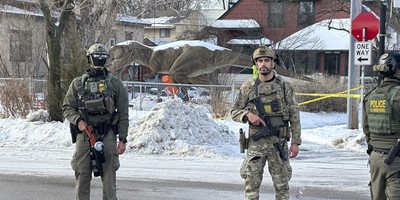To President Barack Obama, securing the border is a laughing matter -- and a lying matter.
When Obama spoke in El Paso, Texas, yesterday, he claimed that (1) the federal government has now "basically" completed the border fence that security minded Republicans wanted built and (2) El Paso and other border communities are "among the safest in the nation."
"They wanted a fence. Well, the fence ... is now basically complete," said Obama.
"Maybe they'll need a moat," he added. "Maybe they want alligators in the moat."
"El Paso and other cities and towns along this border are consistently among the safest in the nation," said Obama. What are the facts?
In 2006, Congress passed -- and President George W. Bush signed -- the Secure Fence Act, sponsored by House Homeland Security Chairman Peter King, R-N.Y.
King explained it on the House floor. "It provides over 700 miles of two-layered reinforced fencing," he said. "It also mandates that the Department of Homeland Security achieve and maintain operational control over the entire border through a virtual fence, deploying cameras, ground sensors, unmanned aerial vehicles, integrated surveillance technology."
The original law left little to interpretation by the homeland security secretary. It said "'operational control' means the prevention of all unlawful entries into the United States."
It defined the type of fence to be built: The "secretary of Homeland Security shall provide for least 2 layers of reinforced fencing, the installation of additional physical barriers, roads, lighting, cameras, and sensors."
So, did the secretary seek to gain operational control of the entire border? Did the secretary build over 700 miles of two-layered reinforced fencing?
The answers are: No and no.
As noted in this column last week, Richard Stana, director of homeland security issues for the Government Accountability Office, informed the Senate Homeland Security Committee in March that there are only 129 miles of the 1,954-mile-long U.S.-Mexico border where the Border Patrol can prevent or stop an illegal entry from taking place at the border itself. There are another 744 miles where it can stop an illegal entry at "distances of up to 100 miles or more away from the immediate border."
Recommended
That leaves at least 1,081 miles of border where Homeland Security has anything but "operational control."
In written testimony presented to the committee on May 4, 2010, Stana said Homeland Security had built 646 miles of border fence (of 652 miles it intended to build) as of April 2010. This generally was not the "2 layers of reinforced fencing" described in the Secure Border Act. Three hundred forty-seven miles was what the GAO described as "pedestrian" fencing, and 299 miles was "vehicle" fencing.
"Pedestrian fencing is designed to prevent people on foot from crossing the border and vehicle fencing consists of physical barriers meant to stop the entry of vehicles," Stana testified.
This March, Stana told the committee that Homeland Security had increased the total length of border fence to 649 miles -- an increase of 3 miles in a year.
Given that Stana also said there were only 129 miles of border where the Border Patrol could prevent or stop an illegal entry at the border, that means there must be at least 520 miles of fencing erected by Homeland Security that does not stop or prevent people from crossing the border.
How did Homeland Security get away with not building the type of double-fencing expressly mandated in the Secure Fence Act?
Sen. Kay Bailey Hutchison, R-Texas, slipped language into the 614-page omnibus spending bill enacted at the end of 2007. This language essentially repealed the Secure Fence Act. It said: "Notwithstanding subparagraph (A), nothing in this paragraph shall require the Secretary of Homeland Security to install fencing, physical barriers, roads, lighting, cameras, and sensors in a particular location along an international border of the United States, if the Secretary determines that the use or placement of such resources is not the most appropriate means to achieve and maintain operational control over the international border at such location."
Are border cities like El Paso truly rated among the safest in the nation? President Obama did not say whose rating he was using. But they are not the safest, according to the U.S. Justice Department.
The latest annual statistical report of the Executive Office for the United States Attorneys -- which was published in 2010 and covers fiscal 2009 -- made a special point of highlighting violence on the border.
"Violence along the border of the United States and Mexico has increased dramatically during recent years," the report said. "The violence associated with Mexican drug trafficking organizations pose(s) a serious problem for law enforcement."
"Illegal immigration provides the initial foothold with which criminal elements, including organized crime syndicates, use to engage in a myriad of illicit activities ranging from immigration document fraud and migrant smuggling to human trafficking," said the report. "Federal prosecution of border crime is a critical part of our Nation's defense and federal jurisdiction over these offenses is exclusive."
As noted in this column last year, the report pointed out that when measured by the number of criminal defendants charged during fiscal 2009, the five most-crime-ridden U.S. judicial districts were all on the Mexican border. These included: Southern Texas, Western Texas, Southern California, Arizona and New Mexico.
According to Obama's Justice Department, there were more then two-and-a-half-times as many criminals (8,435) charged in federal court in Western Texas, where El Paso is, than in the combined districts of Southern New York (1,959), which includes Manhattan and the Bronx, and the Eastern New York (1,377), which includes Staten Island, Brooklyn, Queens and Long Island.

























Join the conversation as a VIP Member